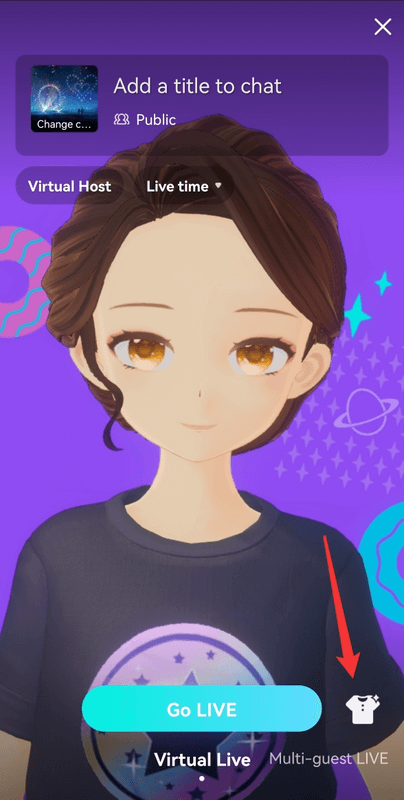In recent years, the world of content creation has seen the rise of a unique and exciting phenomenon: Virtual YouTubers, or VTubers. These digital personalities have taken the streaming world by storm, offering a blend of entertainment, creativity, and technology that captivates audiences worldwide.
If you’ve been wondering how to become a VTuber yourself, you’re in the right place. This comprehensive guide will walk you through the process, with a special focus on using BIGO LIVE’s Virtual Live feature and 3D avatars.

What is VTubing and VTuber?
Before diving into the specifics of becoming a VTuber, it’s essential to understand what VTubing entails. A VTuber is a content creator who uses a virtual avatar to represent themselves online, typically in live streams or pre-recorded videos. These avatars can range from 2D anime-style characters to more realistic 3D models, and they’re animated in real-time to mirror the creator’s movements and expressions. VTubing offers several unique advantages:
- Privacy: Creators can maintain anonymity while still connecting with their audience.
- Creativity: Virtual avatars allow for endless possibilities in terms of character design and presentation.
- Accessibility: VTubing can be less intimidating for those who are camera-shy but still want to create content.
- Consistency: Avatars provide a consistent look across all streams, regardless of the creator’s physical appearance.
Getting Started: Essential Equipment and Software
To begin your VTubing journey, you’ll need some basic equipment and software:
1. A device for streaming
- Smartphone: Most modern smartphones, especially iPhones or high-end Android devices, are capable of VTubing.
- Computer (optional): For more advanced features, a PC with at least a 2.5 GHz processor, 8GB RAM, and a decent graphics card is recommended.
2. Camera
- Smartphone camera is usually sufficient for face tracking.
- For PC users, a webcam like Logitech C920 or NexiGo N60 can provide better results.
3. Microphone: Start with your device’s built-in microphone or an affordable external microphone with a pop filter.
4. Lighting: Proper lighting helps with motion tracking. Begin with desk lamps or affordable LED panels.
5. Other Essential Software
(1) Avatar Creation Software
- VRoid Studio (free): For creating 3D avatars.
- Live2D: For creating 2D avatars.
(2) Face Tracking Software
- For 3D avatars: VSeeFace (free)
- For 2D avatars: VTube Studio (free)
(3) Streaming Software
- OBS (Open Broadcaster Software): Free and widely used for broadcasting streams.
- Streamlabs Desktop: Another popular option with built-in Spout2 support for easy VTuber avatar integration.
Creating Your VTuber Persona
One of the most exciting aspects of becoming a VTuber is creating your virtual persona. This involves several key steps:
1. Develop your character: Think about your avatar’s personality, backstory, and unique traits. What makes them stand out?
2. Design your avatar: You can create your own using software like VRoid Studio, commission an artist, or purchase a pre-made model from marketplaces.
3. Rig your avatar: This process involves preparing your 2D or 3D model for animation. You may need to learn basic rigging skills or hire a professional rigger.
4. Choose your streaming platform: While YouTube and Twitch are popular choices, platforms like BIGO LIVE offer unique features for VTubers.
BIGO LIVE and Virtual Live: A Game-Changer for VTubers
BIGO LIVE has emerged as an exciting platform for aspiring VTubers, thanks to its innovative Virtual Live feature. This feature allows users to create and customize 3D avatars for streaming, offering a range of options for hairstyles, facial features, fashion choices, and accessories. Here’s how to set up your 3D avatar on BIGO LIVE:
1. Open the BIGO LIVE app and tap the camera icon in the bottom-center of the home page.
2. In “Virtual Live” mode, swipe right and tap the clothing icon near the bottom-right corner of the camera screen.

3. Tap the top icon on the left side to begin creating your 3D avatar.
4. Choose a predesigned avatar style to edit.
5. Customize your avatar’s outfit, facial features, and background using the various options provided.
6. Save your creation and exit the designing page.
Your 3D avatar will now be activated when you start livestreaming, mirroring your facial expressions and head movements in real-time. This feature adds a fun and interactive element to your streams, allowing you to engage with your audience in a unique way.
Conclusion
Becoming a VTuber offers a unique and exciting way to express yourself creatively and connect with audiences worldwide. By leveraging platforms like BIGO LIVE and its Virtual Live feature, you can easily create and customize a 3D avatar that brings your virtual persona to life.
Remember, the key to success as a VTuber lies not just in the technology or the avatar, but in the personality and content you bring to your streams. Be authentic, engage with your audience, and most importantly, have fun with your virtual identity.







